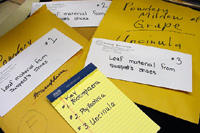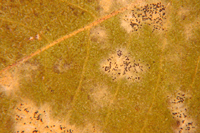Collection Methods
In late summer or autumn collect leaves with mature (black) chasmothecia on plants that show signs (pale, dusty-white coating on leaves) of powdery mildew. The chasmothecia should be visible to your eye without the aid of a magnifying glass. Asters, azalea, cherry, filbert, grape, horse chestnut, lilac, oak, phlox, rose, zinnia, evening primrose (Oenothera spp., often called sundrops), viburnum, wheat, willow and many other shrubs, trees, flowers, weeds and garden plants are good sources of chasmothecia.
Leaves exhibiting abundant chasmothecia are good specimens for teaching purposes. Infected leaves should be pressed flat between pieces of newspaper. Pressed, dried, leaf specimens can be stored in envelopes for use over many years. Label the envelope with the pressed leaves giving the name of the plant, the powdery mildew genus (you will need to identify the genus with the forensic key and diagrams), and location of collection, for future reference. For your own purposes of cataloguing and ease of choosing teaching material for labs, you may want to number your envelopes and keep a separate list of the specific genera of powdery mildew found to be associated with each plant collected. You will find that several different genera of powdery mildew will infect the same host type. For example, Erysiphe sect.Microsphaera and Phyllactinia may both be found on oak. This is why it is important to label your envelopes by powdery mildew genus and not host plant.
Lab Preparation
- Set out four empty envelopes and your envelopes of pressed, dried, leaf material infected with powdery mildew and covered with chasmothecia.
- Take three empty envelopes and label each of them "Leaf Material from Suspect's Shoes."
- Label the three envelopes #1, #2, or #3.
Note: for a large class you may want to make duplicate envelopes of each number. (This exercise works best when students work in groups of three or four.)
- Remove several leaves from three of your storage envelopes that contain the pressed, dried, leaf samples of three different known genera of powdery mildew. Be careful to keep the leaves with each different powdery mildew genus separate from each other.
- Cut the leaves, one powdery mildew genus at a time, into smaller pieces. Clean the scissors before cutting the leaves of the next sample.
- Place the cut leaf pieces of each different known powdery mildew genus into one of the numbered envelopes (#1,#2 or #3) labeled "Leaf Material from Suspect's Shoes." Note: the number of cut leaf pieces must equal the number of groups in the class so that each group gets one piece of "Leaf Material from Suspect's Shoes."
- On a separate piece of paper (your key) write down the envelope numbers and the name of the known powdery mildew genera in each numbered envelope.
- Take one empty envelope and label it "Leaf Material from Murder Victim's Shoes."
- Choose one of the three known storage envelopes from which you previously removed leaves (so the Murder Victim sample will match only one of the Suspect samples) and remove several more leaves from that one envelope.
- Cut the leaves from that sample into smaller pieces and place them in the envelope labeled "Leaf Material from Murder Victim's Shoes." Note: the number of total cut leaf pieces in this envelope must equal the number of groups in the class so that each group gets one piece of leaf material from the "Murder Victim."
- Record on your key the name of the known powdery mildew genus that you placed in the envelope labeled "Leaf Material from Murder Victim's Shoes."
Lab Set-up
- Place all of the labeled envelopes ("Leaf Material from Suspect's Shoes" and "Leaf Material from the Murder Victim's Shoes") on a designated table or lab bench.
- Place several black permanent markers or wax pencils on the tables for students to label their petri dishes.
- For each lab group, set up a work station area consisting of :
- dissecting microscope
- compound microscope
- clear tape
- two petri dishes
- forcep
- several microscope slides
- water in dropper bottles.
If supplies are limited, groups can easily share items.
Powerpoint tutorial for class use
Procedures for students
FORENSIC TOOLS
You are a suspect in a murder investigation. You must attempt to prove your innocence and clear your name using dissecting and compound microscopes, clear tape, petri dishes, forceps, microscope slides, a water dropper and a forensic key with the special characteristics of powdery mildew chasmothecia appendages.
FORENSIC LAB PROCEDURES
You may work alone or in a group of three or four.
Collect and label forensic evidence
- First, locate the numbered envelopes labeled "Leaf Material from Suspect's Shoes." (The suspect is YOU!)

Figure 5 |
|
- Choose one of the numbered envelopes labeled "Leaf Material from Suspect's Shoes" and using a forceps, remove a piece of the powdery looking plant material from the numbered envelope and place it in a petri dish you have labeled "Suspect. "Record the number of the envelope on the petri dish and on your data sheet.
- Locate the envelope labeled "Leaf Material from the Murder Victim's Shoes" and using a different or clean forceps remove a piece of the powdery looking plant material from the envelope. Place the plant material in a petri dish you have labeled "Murder Victim." Note: Cleanliness is very important in this process of handling samples with forceps. There are several infamous cases of sloppy handling of forensic evidence that have led to false convictions.
- Take the labeled petri dishes with your pieces of plant material to your work station

Figure 6 |
|
Examine forensic evidence
- Put a small drop of water in the center of a microscope slide.
- Examine the leaf sample labeled "Suspect." The black speck-like chasmothecia should be visible to your eye without the aid of magnification. Place the powdery looking leaf material peppered with black chasmothecia under a dissecting microscope, for increased visibility with magnification.

Figure 7 |
|
- Tear off a piece of clear tape that is approximately half the length of the microscope slide.

Figure 8 |
|
- While looking through the dissecting microscope, press the leaf piece firmly down with one hand. Using your other hand, hold onto one end of the tape and gently touch the rest of the clear tape on top of the black, speck-like chasmothecia. They should stick to the tape. Repeat this process several times on other areas on the leaf surface to gather more chasmothecia.
- Place the tape (sticky side down) on top of the water droplet on the microscope slide. Gently push down on the tape and smooth the tape over the water droplet so that it sticks to the slide. If necessary, more water may be added by squeezing the water dropper gently at the edge of the tape on the slide. The clear tape is an excellent tool for gathering chasmothecia and other fungal structures from a leaf surface. The tape also serves as a cover slip!
- You can quickly check to see if you have successfully transferred chasmothecia to your microscope slide by placing it on a white sheet of paper. If you can see black pinhead-sized specks, then you have chasmothecia. If you do not see tiny black specks then remove the tape from the slide and repeat steps #4 and #5.
- Now place the slide on the stage of the compound microscope and examine the chasmothecia, first under 100x magnification, followed by 200x and 400x (if available).
Identify forensic evidence
- As you examine the chasmothecia with a compound microscope, look at the appendages on the chasmothecia. Carefully examine both the base and tip ends of the appendages on at least fifteen different chasmothecia to be sure you have seen the correct appendage type. This is necessary since tips break off easily, leaving only stringy looking "arms" that might lead you to a false identification. Compare the appendages to the written descriptions and/or the drawings in the keys included with this exercise. Decide what kind of appendages they are, and record this description along with a drawing of the appendage type on the "Forensic Evidence Data Table" located on your Case Study Sheet.
- 2. After observing the appendages, if you need to determine how many asci (spore-containing sacs) are in the chasmothecia, gently press down on the clear tape with the end of the forceps to break the chasmothecia open. It is helpful to look through the microscope at low power (100x) while doing this in order to see the asci pop out of the chasmothecia. Some chasmothecia may be immature and will not contain asci. Once you break open a mature c chasmothecium, how many asci do you see? One ascus or several asci? Record your observations on the Case Study Sheet. This information may be important in your effort to prove yourself innocent.
Repeat Sections B and C (Examination and Identification of Evidence) with the plant material in your petri dish labeled "Murder Victim" including the recording of results.
Forensic Key and Diagrams to the Genera of Powdery Mildew Fungi
Appendages coiled or hooked at tip – Erysiphe sect. Uncinula
Appendages simple and straight with bulb-like base – Phyllactinia
Appendages branching dichotomously (antler-like at tip)
Chasmothecium contains a single ascus - Podospshaera sect. Podospharera
Chasmothecium contains several asci - Erysiphe sect. Microsphaera
Appendages simple or irregularly branched, often entwined
Chasmothecium contains a single ascus - Podosphaera sect. Sphaerotheca
Chasmothecium contains several asci - Erysiphe sect. Erysiphe

Genera of Powdery Mildew Fungi
Modified from: Plant Disease Syllabus, Kenaga, Williams, and Green, Waveland Press, Inc. Prospect Heights, IL. |
Record forensic evidence
Locate the Forensic Evidence Data Table on the Case Study Sheet . Record and draw the type of appendages (arms) found on the surface of the chasmothecia (e.g. hooked tip; bulb-like base; antler-like dichotomous branching; or simple, string-like arms), the number of asci (one or several) contained within each chasmothecium, and the name of the powdery mildew genus.
|
Forensic Evidence Data Table |
|
Characteristics of Chasmothecia |
Powdery Mildew
Genus |
|
Types of Appendages |
Number of asci (sacs) per chasmothecium
(one or several) |
|
Murder Suspect (YOU) #______ |
|
|
|
|
Murder Victim |
|
|
|
